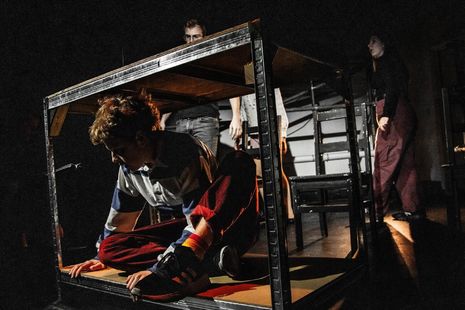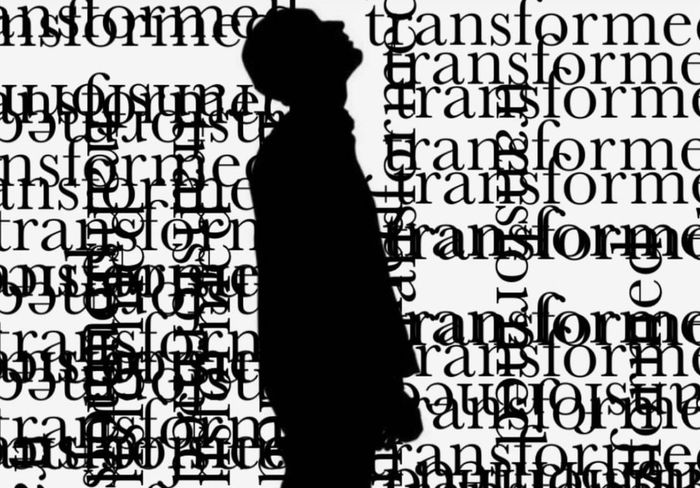Metamorphosis is totally buggin’
Martha Vine finds little to critter-cise in this Kafka adaptation

How do you depict a man becoming a bug? This was the immediate thought I had upon signing up to review the adaption of Kafka’s Metamorphosis. It’s hard enough for any theatre company to mutate an actor from human to insect in real time with a live audience; throw in a university budget, a mere four-by-five metre studio, a five person cast, and you’re going to have to get creative.
Luckily for us, it seems that Emily Sparkes and her team were not lacking in ingenious ideas. Kafka is notoriously difficult to translate to the stage – his strange, twisting surrealism, lack of continuous dialogue, implausible narrative, and often ineffable characters make for fascinating prose, but his writing’s aura of absurdism often dissipates somewhere between the page and the theatre. Metamorphosis is the story of travelling salesman Gregor Samsa who has dedicated his waking hours trying to support his family only to wake up one morning and find himself transformed into a giant beetle. Yes, a giant beetle. You can understand how it might be challenging to replicate this in the Corpus Playroom. But as I found my seat, I was already being transported. Gregor Samsa (Liam Macmillan) hunches on all fours in the dimmed lighting, watching the audience from under the shadow of a table. A clock ticks relentlessly in the background. The scaffolding erected around the borders of the stage casts strange shapes across the seats. The crew have understood that, for a suspension of disbelief to occur (spoiler: there is no beetle suit in use), atmosphere becomes crucial.
“Emily Sparkes and her team were not lacking in ingenious ideas”
It is this attention to detail that allows Metamorphosis to succeed so entirely. Everything has been tuned to perfection; Greta Samsa (Ellie Worth) manages to maintain the posture of someone held in place by strings through the entire play, a feat of bodily control that made me sit up straighter in my seat. Liam's buggish mutation is achieved through carefully pointed toes and twisted fingers, and his vocal degradation as he becomes gradually unable to speak made me question whether he was wired up to a distorted mic. The cast has an interconnectedness so precise that at times they move as one in choreographed sequences of machine-like movement that are just as horrifying as if Liam had been strapped into a bug outfit and started scuttling across the ceiling. This is a play that knows it is working with spatial and costuming limitations, but shows astute innovation in surpassing them. It doesn’t matter that Liam-as-bug remains dressed in his salesperson suit; the cast have been coated in white face-paint and dressed in monochrome that is amplified under the harsh, cold light. Tim Burton would be proud.
“It is this continued bracing for impact that makes Metamorphosis so triumphant”
It’s impossible to review this play without addressing the elephant in the room, or rather, the scaffolding in the Playroom. The Corpus Playroom is a notoriously bare theatre, often used for experimental theatre or one-man shows. I’ve seen performances with as little as one stool on the stage. Thus the metal architecture, built up into layers that Liam is able to creep and writhe among, brings a radically different ambience to a once-familiar space, and cements the anxiety that suffuses the air around us; barren, glinting, and harsh, even the stage’s features have become uncomfortable to look at.
Occasional comedic interludes do little to dispel the oppression that has settled on the audience – we laugh as the family chew their food louder and louder to drown out the strange gurgling and clicking noises of Gregor’s digestive system, but it is a skittish laughter, one tinged by the certainty that something horrible is lurking around the corner, a revelation about human nature far more terrible than the beetle curled up under the scaffolding.
It is this continued bracing for impact, not the plot, nor the climax, that makes Metamorphosis so triumphant – we have been pulled into the horror, swallowed by the aura of unease that is characteristic of Kafka. Metamorphosis scurries under the skin of its audience, but when the lights came back up, I was disappointed to find it over. Berkoff has written a piece of enticing horror that draws you in just as it repulses, and Emily’s crew have conveyed this duality masterfully, keeping the audience tensed until lights drop and we take a collective breath. That is theatre.
 News / Eight Cambridge researchers awarded €17m in ERC research grants27 December 2025
News / Eight Cambridge researchers awarded €17m in ERC research grants27 December 2025 News / Downing investigates ‘mysterious’ underground burial vault 29 December 2025
News / Downing investigates ‘mysterious’ underground burial vault 29 December 2025 Lifestyle / Ask Auntie Alice29 December 2025
Lifestyle / Ask Auntie Alice29 December 2025 Sport / Hard work, heartbreak and hope: international gymnast Maddie Marshall’s journey 29 December 2025
Sport / Hard work, heartbreak and hope: international gymnast Maddie Marshall’s journey 29 December 2025 Interviews / Meet Juan Michel, Cambridge’s multilingual musician29 December 2025
Interviews / Meet Juan Michel, Cambridge’s multilingual musician29 December 2025










